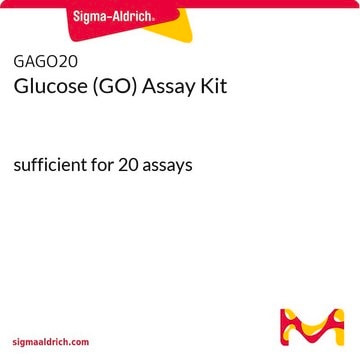The supplier advises that they have not yet validated any lysis buffers for use with cell samples in conjunction with this kit. Additionally, they recommend using an untreated, clear, flat-bottom plate for colorimetric measurements. Therefore, it would be preferable to transfer the samples to such a plate for running the assay.
MAK317
Sorbitol Dehydrogenase Assay Kit
sufficient for 100 colorimetric tests
Seleccione un Tamaño
Seleccione un Tamaño
About This Item
Productos recomendados
método de detección
colorimetric
enfermedades relevantes
endocrinological disorders, diabetes; gastrointestinal diseases
temp. de almacenamiento
−20°C
Categorías relacionadas
Descripción general
Características y beneficios
Idoneidad
Principio
Palabra de señalización
Warning
Frases de peligro
Consejos de prudencia
Clasificaciones de peligro
Eye Irrit. 2 - Flam. Liq. 3 - Met. Corr. 1 - Skin Irrit. 2 - STOT SE 3
Órganos de actuación
Respiratory system
Código de clase de almacenamiento
3 - Flammable liquids
Punto de inflamabilidad (°F)
75.2 °F - closed cup
Punto de inflamabilidad (°C)
24 °C - closed cup
Elija entre una de las versiones más recientes:
Certificados de análisis (COA)
It looks like we've run into a problem, but you can still download Certificates of Analysis from our Documentos section.
Si necesita más asistencia, póngase en contacto con Atención al cliente
¿Ya tiene este producto?
Encuentre la documentación para los productos que ha comprado recientemente en la Biblioteca de documentos.
-
What are the recommended methods for homogenizing or lysing cells in a 96-well plate for the MAK317 Sorbitol Dehydrogenase assay kit? The manual advises against using proteolytic enzymes and suggests using a rubber policeman, which is not suitable for a 96-well plate. Are there any recommendations for a mild lysing buffer with minimal impact on the assay outcome? Additionally, is it possible and recommended to run the assay in the same 96-well plate, or is transferring the samples to a new plate necessary?
1 answer-
Helpful?
-
Active Filters
Nuestro equipo de científicos tiene experiencia en todas las áreas de investigación: Ciencias de la vida, Ciencia de los materiales, Síntesis química, Cromatografía, Analítica y muchas otras.
Póngase en contacto con el Servicio técnico







